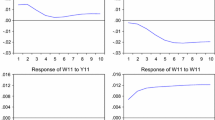Abstract
Already ancients noticed that decrease is usually faster than growth—whether we talk about companies or empires. A modern researcher Ugo Bardi confirmed that this phenomenon is still valid today. He called it Seneca effect, after the ancient philosopher Seneca—one of those who observed this phenomenon. In this paper, we provide a natural explanation for the Seneca effect.
Access this chapter
Tax calculation will be finalised at checkout
Purchases are for personal use only
Similar content being viewed by others
References
U. Bardi, The Seneca Effect: Why Growth is Slow But Collapse is Rapid (Springer, Cham, 2017)
P.C. Fishburn, Utility Theory for Decision Making (Wiley, New York, 1969)
P.C. Fishburn, Nonlinear Preference and Utility Theory (The John Hopkins Press, Baltimore, 1988)
D. Kahneman, Thinking, Fast and Slow (Farrar, Straus, and Giroux, New York, 2011)
V. Kreinovich, Decision making under interval uncertainty (and beyond), in Human-Centric Decision-Making Models for Social Sciences. ed. by P. Guo, W. Pedrycz (Springer, Berlin, 2014), pp.163–193
R.D. Luce, R. Raiffa, Games and Decisions: Introduction and Critical Survey (Dover, New York, 1989)
H.T. Nguyen, O. Kosheleva, V. Kreinovich, Decision making beyond Arrow’s ‘impossibility theorem’, with the analysis of effects of collusion and mutual attraction. Int. J. Intell. Syst. 24(1), 27–47 (2009)
H.T. Nguyen, V. Kreinovich, B. Wu, G. Xiang, Computing Statistics under Interval and Fuzzy Uncertainty (Springer, Berlin, 2012)
H. Raiffa, Decision Analysis (McGraw-Hill, Columbus, 1997)
R.T. Rockafeller, Convex Analysis (Princeton University Press, Princeton, 1997)
L.A. Seneca, Letters on Ethics: to Lucilius (University of Chicago Press, Chcago, 2017)
Acknowledgements
This work was supported in part by the National Science Foundation grants 1623190 (A Model of Change for Preparing a New Generation for Professional Practice in Computer Science), and HRD-1834620 and HRD-2034030 (CAHSI Includes), and by the AT&T Fellowship in Information Technology.
It was also supported by the program of the development of the Scientific-Educational Mathematical Center of Volga Federal District No. 075-02-2020-1478, and by a grant from the Hungarian National Research, Development and Innovation Office (NRDI).
Author information
Authors and Affiliations
Corresponding author
Editor information
Editors and Affiliations
Rights and permissions
Copyright information
© 2023 The Author(s), under exclusive license to Springer Nature Switzerland AG
About this chapter
Cite this chapter
Aguilar, S.R., Kreinovich, V. (2023). Why Seneca Effect?. In: Ceberio, M., Kreinovich, V. (eds) Uncertainty, Constraints, and Decision Making. Studies in Systems, Decision and Control, vol 484. Springer, Cham. https://doi.org/10.1007/978-3-031-36394-8_11
Download citation
DOI: https://doi.org/10.1007/978-3-031-36394-8_11
Published:
Publisher Name: Springer, Cham
Print ISBN: 978-3-031-36393-1
Online ISBN: 978-3-031-36394-8
eBook Packages: Intelligent Technologies and RoboticsIntelligent Technologies and Robotics (R0)




